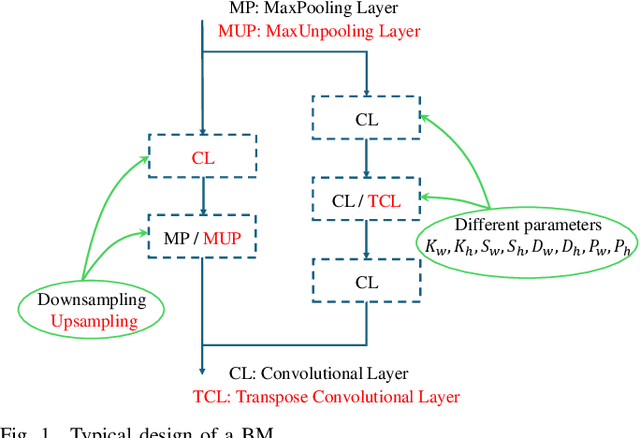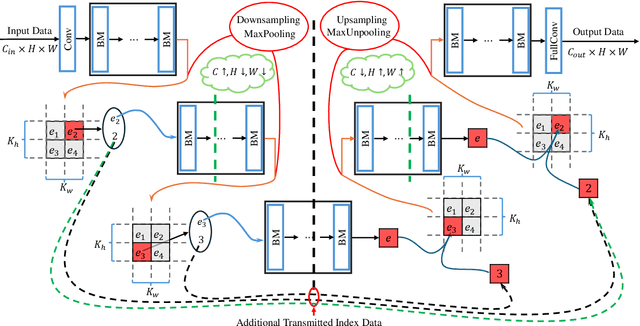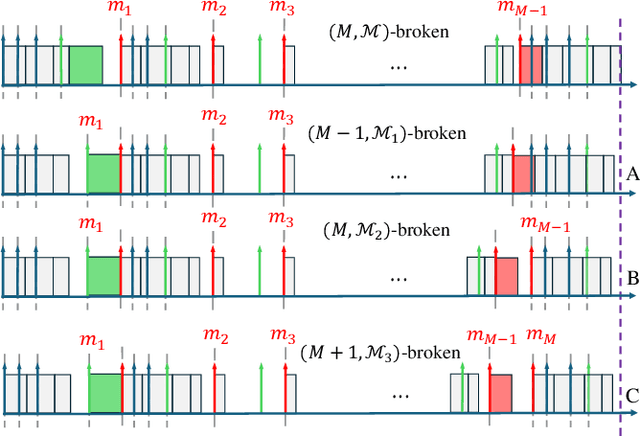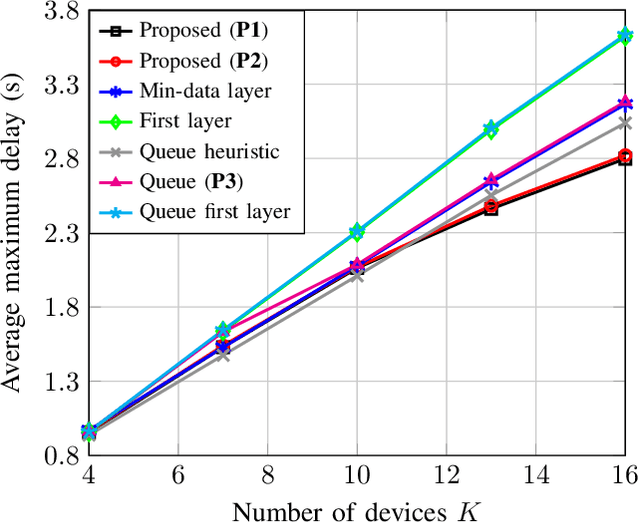Nikos A. Mitsiou
Split Learning in Computer Vision for Semantic Segmentation Delay Minimization
Dec 18, 2024



Abstract:In this paper, we propose a novel approach to minimize the inference delay in semantic segmentation using split learning (SL), tailored to the needs of real-time computer vision (CV) applications for resource-constrained devices. Semantic segmentation is essential for applications such as autonomous vehicles and smart city infrastructure, but faces significant latency challenges due to high computational and communication loads. Traditional centralized processing methods are inefficient for such scenarios, often resulting in unacceptable inference delays. SL offers a promising alternative by partitioning deep neural networks (DNNs) between edge devices and a central server, enabling localized data processing and reducing the amount of data required for transmission. Our contribution includes the joint optimization of bandwidth allocation, cut layer selection of the edge devices' DNN, and the central server's processing resource allocation. We investigate both parallel and serial data processing scenarios and propose low-complexity heuristic solutions that maintain near-optimal performance while reducing computational requirements. Numerical results show that our approach effectively reduces inference delay, demonstrating the potential of SL for improving real-time CV applications in dynamic, resource-constrained environments.
Hybrid Semantic-Shannon Communications
Oct 02, 2024Abstract:Semantic communications are considered a promising beyond-Shannon/bit paradigm to reduce network traffic and increase reliability, thus making wireless networks more energy efficient, robust, and sustainable. However, the performance is limited by the efficiency of the semantic transceivers, i.e., the achievable "similarity" between the transmitted and received signals. Under strict similarity conditions, semantic transmission may not be applicable and bit communication is mandatory. In this paper, for the first time in the literature, we propose a multi-carrier Hybrid Semantic-Shannon communication system where, without loss of generality, the case of text transmission is investigated. To this end, a joint semantic-bit transmission selection and power allocation optimization problem is formulated, aiming to minimize two transmission delay metrics widely used in the literature, subject to strict similarity thresholds. Despite their non-convexity, both problems are decomposed into a convex and a mixed linear integer programming problem by using alternating optimization, both of which can be solved optimally. Furthermore, to improve the performance of the proposed hybrid schemes, a novel association of text sentences to subcarriers is proposed based on the data size of the sentences and the channel gains of the subcarriers. We show that the proposed association is optimal in terms of transmission delay. Numerical simulations verify the effectiveness of the proposed hybrid semantic-bit communication scheme and the derived sentence-to-subcarrier association, and provide useful insights into the design parameters of such systems.
Waveform Design for Over-the-Air Computing
May 31, 2024Abstract:In response to the increasing number of devices anticipated in next-generation networks, a shift toward over-the-air (OTA) computing has been proposed. Leveraging the superposition of multiple access channels, OTA computing enables efficient resource management by supporting simultaneous uncoded transmission in the time and the frequency domain. Thus, to advance the integration of OTA computing, our study presents a theoretical analysis addressing practical issues encountered in current digital communication transceivers, such as time sampling error and intersymbol interference (ISI). To this end, we examine the theoretical mean squared error (MSE) for OTA transmission under time sampling error and ISI, while also exploring methods for minimizing the MSE in the OTA transmission. Utilizing alternating optimization, we also derive optimal power policies for both the devices and the base station. Additionally, we propose a novel deep neural network (DNN)-based approach to design waveforms enhancing OTA transmission performance under time sampling error and ISI. To ensure fair comparison with existing waveforms like the raised cosine (RC) and the better-than-raised-cosine (BRTC), we incorporate a custom loss function integrating energy and bandwidth constraints, along with practical design considerations such as waveform symmetry. Simulation results validate our theoretical analysis and demonstrate performance gains of the designed pulse over RC and BTRC waveforms. To facilitate testing of our results without necessitating the DNN structure recreation, we provide curve fitting parameters for select DNN-based waveforms as well.
Energy-aware Trajectory Optimization for UAV-mounted RIS and Full-duplex Relay
Jan 22, 2024Abstract:In the evolving landscape of sixth-generation (6G) wireless networks, unmanned aerial vehicles (UAVs) have emerged as transformative tools for dynamic and adaptive connectivity. However, dynamically adjusting their position to offer favorable communication channels introduces operational challenges in terms of energy consumption, especially when integrating advanced communication technologies like reconfigurable intelligent surfaces (RISs) and full-duplex relays (FDRs). To this end, by recognizing the pivotal role of UAV mobility, the paper introduces an energy-aware trajectory design for UAV-mounted RISs and UAV-mounted FDRs using the decode and forward (DF) protocol, aiming to maximize the network minimum rate and enhance user fairness, while taking into consideration the available on-board energy. Specifically, this work highlights their distinct energy consumption characteristics and their associated integration challenges by developing appropriate energy consumption models for both UAV-mounted RISs and FDRs that capture the intricate relationship between key factors such as weight, and their operational characteristics. Furthermore, a joint time-division multiple access (TDMA) user scheduling-UAV trajectory optimization problem is formulated, considering the power dynamics of both systems, while assuring that the UAV energy is not depleted mid-air. Finally, simulation results underscore the importance of energy considerations in determining the optimal trajectory and scheduling and provide insights into the performance comparison of UAV-mounted RISs and FDRs in UAV-assisted wireless networks.
Power-Optimal HARQ Protocol for Reliable Free Space Optical Communication
Mar 30, 2023Abstract:This paper investigates the usage of hybrid automatic repeat request (HARQ) protocols for power-efficient and reliable communications over free space optical (FSO) links. By exploiting the large coherence time of the FSO channel, the proposed transmission schemes combat turbulence-induced fading by retransmitting the failed packets in the same coherence interval. To assess the performance of the presented HARQ technique, we extract a theoretical framework for the outage performance. In more detail, a closed-form expression for the outage probability (OP) is reported and an approximation for the high signal-to-noise ratio (SNR) region is extracted. Building upon the theoretical framework, we formulate a transmission power allocation problem throughout the retransmission rounds. This optimization problem is solved numerically through the use of an iterative algorithm. In addition, the average throughput of the HARQ schemes under consideration is examined. Simulation results validate the theoretical analysis under different turbulence conditions and demonstrate the performance improvement, in terms of both OP and throughput, of the proposed HARQ schemes compared to fixed transmit power HARQ benchmarks.
Accelerating Distributed Optimization via Over-the-Air Computing
Dec 28, 2022Abstract:Distributed optimization is ubiquitous in emerging applications, such as robust sensor network control, smart grid management, machine learning, resource slicing, and localization. However, the extensive data exchange among local and central nodes may cause a severe communication bottleneck. To overcome this challenge, over-the-air computing (AirComp) is a promising medium access technology, which exploits the superposition property of the wireless multiple access channel (MAC) and offers significant bandwidth savings. In this work, we propose an AirComp framework for general distributed convex optimization problems. Specifically, a distributed primaldual (DPD) subgradient method is utilized for the optimization procedure. Under general assumptions, we prove that DPDAirComp can asymptotically achieve zero expected constraint violation. Therefore, DPD-AirComp ensures the feasibility of the original problem, despite the presence of channel fading and additive noise. Moreover, with proper power control of the users' signals, the expected non-zero optimality gap can also be mitigated. Two practical applications of the proposed framework are presented, namely, smart grid management and wireless resource allocation. Finally, numerical results reconfirm DPDAirComp's excellent performance, while it is also shown that DPD-AirComp converges an order of magnitude faster compared to a digital orthogonal multiple access scheme, specifically, time division multiple access (TDMA).
 Add to Chrome
Add to Chrome Add to Firefox
Add to Firefox Add to Edge
Add to Edge